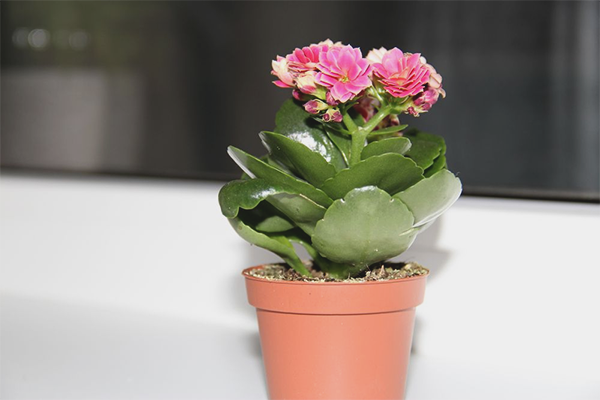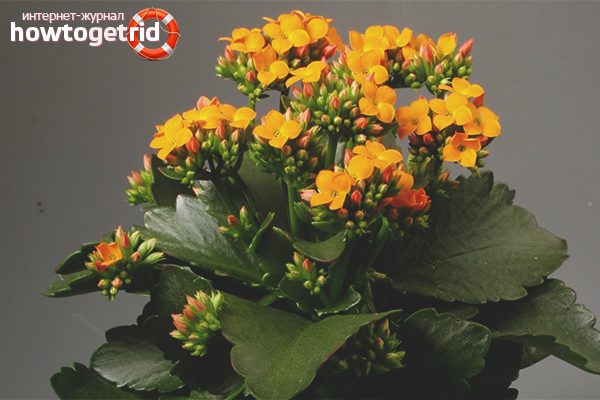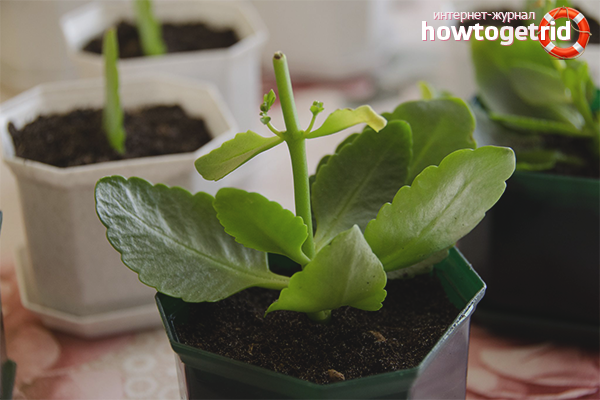The content of the article
How to care for Kalanchoe at home? Someone will say - why take care of him, it grows by itself. This is yes, growing and even brings great benefits. That's just somehow. Elongated, long, does not bloom, the trunk is bald. Palma, not Kalanchoe.
But with minimal care, you can get a beautiful lush bush with a huge hat of bright colors. And no special effort is required, this plant is so unpretentious. A little attention and you will have the joy and benefit.
We choose the soil
It will be more accurate to say - we collect it ourselves. No, of course you can buy a special pochvosmes in the store. But who knows what is mixed there? Let's do it yourself. Land for Kalanchoe should not be very fertile, one might even say poor.Make it yourself is not difficult. All you need is 1 part of sand, garden soil, brick chips and peat. Add a handful of coal from hardwood trees, mix and ready.
Despite the very scanty composition, Kalanchoe prefers just such a poorly nourished land.
What should be the pot
It is necessary to transplant Kalanchoe by transshipment method and as carefully as possible. He has very fragile stems and leaves. When pressed, they fall off with a characteristic chpokom. If this happens, then do not worry. Quietly root debris in water or soil. And now, you have more than one plant, but several.
Breeding
You can propagate Kalanchoe as convenient. These are seeds, processes, cuttings, leaves, children.All green grows well and quickly gives roots. And for greater beauty, plant several varieties of Kalanchoe in a wide low capacity. In the spring, with proper care, you will have such a bouquet of bright flowers with juicy shades that you will die from envy of yourself.
Seeds are sown directly on the ground and covered with glass. Top of the earth they do not sprinkle. In a week you will see sprouts, and after a month and a half you can plant a young plant on a permanent place. Caring for him is not much different from caring for an adult.
How to achieve flowering Kalanchoe
Gently turn to the theme of flowers. Those who argue that it is they who grow a non-flowering variety are deeply mistaken. Absolutely all types and varieties of plants bloom. It is important to know the conditions under which flower buds are laid.
The flower is thermophilic, it comes from Madagascar. But after all, the summer of the southern hemisphere is characterized by a short daylight hours and cool weather. So, creating an artificial summer Kalanchoe, close to the natural habitats, in the spring you can admire the lush flowering.
To do this, from September to December the plant should receive coverage of no more than 10 hours.How to achieve this? For example, from 7 o'clock in the morning until 17 o'clock in the evening, the pot with it should stand on the windowsill or under a fluorescent lamp. And from 17.00 to 7.00 the pot is removed in a dark place. In the closet, in the pantry. No such opportunity? So cover the plant with a dense cloth or box.
In winter, it is easier to do, because the day itself is short. But in the fall will have to try a little. But for yourself?
The temperature at this time should not exceed 18 ° С, but should not be lower than 10 ° С. This is the best mode for bookmarking flower buds. Starting from January, they gradually increase the length of daylight hours, bringing it to March up to 12 hours. The temperature of the content is also increased, bringing to 23 ° C.
Watering gradually increase.
Watering
Does not like water Kalanchoe. If only quite a bit. That is, it should be watered when the earth lump dries out, plus two more days. No need to worry that the plant will die. In its nature, it is possible to survive in arid conditions, accumulating water in the leaves and gradually spending it on their own needs.
For the same reason, you can never pour a flower from the heart.It will work like a pump. That is, it will pump out all possible moisture from the soil, but it will not have time to consume it. Because seeing the dry land, you will water it again. And Kalanchoe again will be pumped up with water. And then it just starts to rot.
For the same reason, never leave excess liquid in the pan. The flower will surely absorb it, in reserve. It is better to wipe the pan dry immediately after watering.
The temperature of the water should be felt by the hand, as cool. Warm liquid contributes to the decay of the root system.
Humidity can also play a cruel joke with Kalanchoe. It does not know how to drink the surface of the leaves, like plants familiar to our latitudes. Excess moisture settles on the leaves, like dew. And stays there before drying out. And if the air around is damp, it does not dry at all. But the spores of fungi and pathogenic bacteria are just waiting for a raw environment to begin to develop vigorous activity. Then you should not be surprised where this infection came from. Themselves and lit.
The drier the air, the better for Kalanchoe.
Still sick. What to do?
First, try to wash the surface of the sheet plates with a weak solution of household or potassium soap.At the same time be sure to wrap the pot tightly with cling film or a tight bag so that the liquid does not get into the soil. After rinse the plant under a soft stream of warm water and dry the leaves. No doubt, a little bit troublesome. But they themselves ruined the flower - themselves and save.
You can try to dry the leaves with a hairdryer. Only from afar and strictly cool stream. A stream of hot air can burn the leaves. But it is not very reliable, because you can skip small drops. And wiping with a cloth, you accurately see each leaf and stem.
If such manipulations do not help, then cut off the healthy parts of Kalanchoe and root them. The rest without regret throwing out. By the way, do not try to save the flower fungicides. Most of them work only when they fall into the cell sap of the plant when it is absorbed from the surface of the stems and leaves. Kalanchoe does not know how. It will get drunk with its roots and just die. Or reset absolutely all the leaves.
And temporarily set aside the diseased plant from other flowers to one side so that the sore does not spread to them.
About pests
Although the flower and foreign, but local pests with pleasure they regale. Not everything, but there are lovers. This aphid, spider mites and worms. First wash off with a stream of water or poison any insecticides. Be sure to watch the instructions and do not exceed the dosage. Naturally, they cover the soil in a pot with a package so that the poison does not fall into the ground. Otherwise, the flower she feasts from the heart. From the second they get rid of, replacing completely the earth in a pot with a new one. By the way, it is desirable to pre-sanitize it with a hot strong solution of potassium permanganate, roasting in an oven or weekly freezing.
The infected plant is preferably placed in quarantine for a while. Otherwise, all these nasty inhabitants will switch to neighboring flowers and will calmly burst them.
Feedings
Absolutely not to overfeed Kalanchoe! Recall the poor composition of the soil mixture. In the period from August to January, the plant does not give any fertilizer. From February to July, occasionally, once a month you can pamper the flower with any mineral mixture for succulents. It is possible for cacti. If you have a favorite mineral water for indoor flowers and you are confident in its quality and benefits, then use it.
How much to feed? Calculate is very simple. We read the recommendation on the packaging and boldly divide in half. Or even into three parts. And only then feed up. And do not increase the dose! The plant will absorb everything that will be in the ground, and then just throw off supersaturated leaves. Instead of a fluffy hat, get a palm trunk with a small tuft at the top of the head.
Formation of Kalanchoe
Palma can turn out by itself. If Kalanchoe does not form, then it will grow by itself with a long stem and will shed the lower leaves. In order to avoid this, be sure to pinch all the crown on the shoots. At first it will be the central stem, and only then the stepchildren.
Just start as early as possible. Immediately after the appearance of the 6th leaf, pinch off it and a 5 leaf with a piece of cutting. If you start later, the stepchildren will not grow all over the stalk, but only from the topmost leaves. As a rule, they always get two. In this situation, you risk getting the most ordinary slingshot, which is a little like a bushy bush.
And if you plant on the street
In the open ground Kalanchoe can be planted only in the southern regions.In the middle lane, mobility is needed so that if the weather deteriorates or the rain approaches, you can quickly remove the flower to a more suitable place.
But to take to the street to cool off after winter, you can start at a temperature of + 12 ° C. The flower tolerates this calmly. Just do not leave it in the sun all day. Choose a place where the sun shines from the morning until 12 o'clock in the afternoon. Either after lunch, light a Kalanchoe with a cloth or tight barrier.
What is a medicinal flower
Not all varieties of Kalanchoe have healing properties. If you are buying a plant for medical purposes, then choose one whose leaves are long, triangular and narrow. By the way, they say about him that it does not bloom. Bullshit! Blossoms, and even how, pink small flowers, gathered in a panicle.
And if you need only for aesthetic pleasure and affection of the soul, then pay attention to the round-leaved varieties. They give the very legendary fluffy hats of a wide variety of colors. By the way, the more you cut wilted flower stalks, the more new the plant will throw out.
Valuable tips
- If your flower looks great, but the leaves have started to change the shade to reddish, then this means that they have overfed with light. Reduce the lighting.
- The same signs, but the color of the leaves does not change, and refuses to bloom? It means either they overfed with fertilizers, or did not observe the light regime.
- When watering, try to keep the liquid from falling on the leaves, stems and flowers. If this happens, with a dry cloth or soft cloth, remove all the droplets to a single. Otherwise, you will then treat your pet for fungal and viral diseases. Even one drop can destroy a plant completely.
- After flowering is necessary to cut the peduncle with a small piece of the stem. If this is not done, the plant may begin to rot directly from the crown. Yes, and the strength will be spent on tying seeds.
- Kalanchoe does not like spraying. The only thing they do is remove dust from the surface of the leaves. And be sure to wipe them dry afterwards!
- Do not feel sorry for Kalanchoe when you do the forming trim. Skip at least one escape and after a week a good whip will hang on this place. For the flower grows at a catastrophic speed.Beautiful shape then fail.
- Usually the plant blooms for two months, at least three. But today, the selection offers such varieties that bloom without interruption up to 6 months! At the same time, they have very beautiful terry flowers, which give Kalanchoe an even greater decorative effect.
- As a rule, they buy a flower after winter, closer to March. Then it just blooms. Replace the plant immediately after purchase. Even if it already pleases you with a magnificent head of inflorescence. Suppose now you lose one year, but save the whole Kalanchoe for subsequent joy. Purchase soil is not suitable for a long stay there roots. He is crammed with various stimulants. And makes the flower give all the vitality. If you leave it to grow in such a soil, it will soon die.
How to care for Kalanchoe at home? Actually it is not difficult. Minimum water and food, a little dances with the light mode, and now you are already the owner of a beautiful bush. In addition, also therapeutic.
Video: how to grow Kalanchoe at home













To send